Deer Antler Growth
Antler growth in deer really is phenomenal! In fact, deer antlers are among the fastest growing tissues in the animal kingdom. They grow as much as 1/2-inch per day during peak antler growth! Of course, the amount of antler material a buck grows depends upon nutrition, genetics, and age. Let’s look at some factors that effect deer antler growth.
Actively growing antlers are covered with a living tissue called velvet; because it really looks and feels like velvet fabric. A buck’s antlers are both extremely delicate and sensitive to the touch during antler development. Bucks are not aggressive towards each other during the antler growing period. However, this is still the time when most deer antler damage occurs.
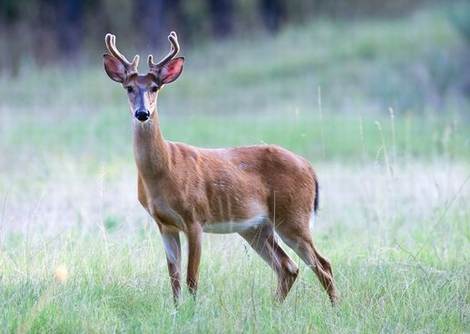
Growing antlers are sensitive. As a result, disputes between bucks at this time are handled by bucks standing on their hind legs and swinging their front legs in the same manner than doe deer use to fight and establish dominance. This technique allows groups of bachelor bucks to sort things out, so to speak. More importantly, it keeps their all-important headgear intact.
Key factors of annual buck antler growth in whitetail include:
- Age of buck
- Nutrition available to the buck
- Stress (physical) from prior breeding season
- Genetic potential for antler growth
- Older bucks typically shed & start growth first
Video: Whitetail Buck Antler Growth
Antler Growth in Bucks
White-tailed deer antler growth usually begins during the month of March or April. Buck antler development ceases by August or early September. In most cases, typical deer antlers begin growing out a buck’s head in a backward motion then quickly change direction and sweep forward as we commonly know.
So how long does it take for a buck to form hardened antlers? The following photos illustrate antler growth for a single white-tailed buck in Texas (in a research facility) from March through September. Take a look at these stages of antler growth. It all happens relatively fast!
Antler Growth Photos by Month
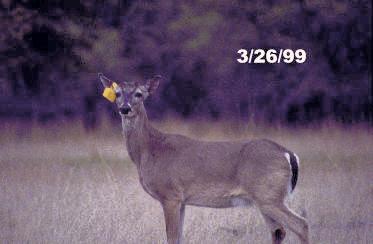
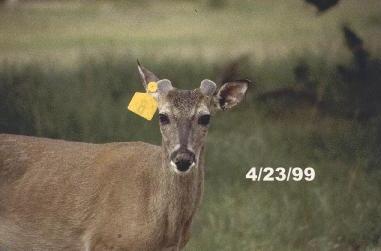
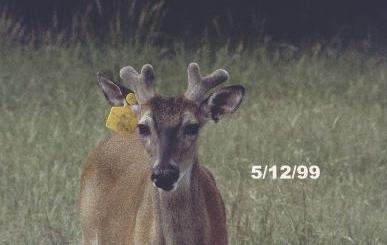
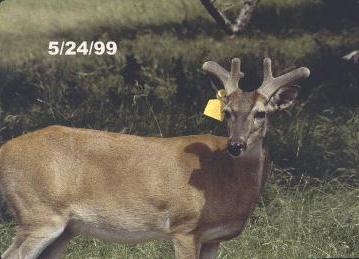
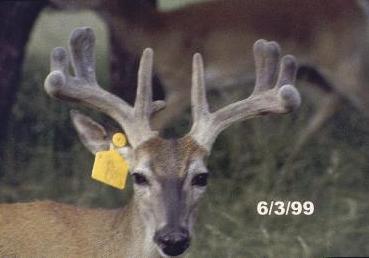
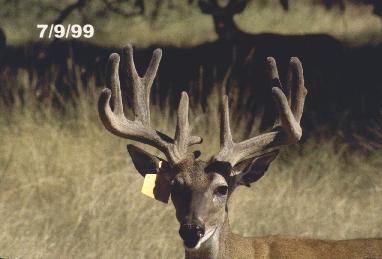
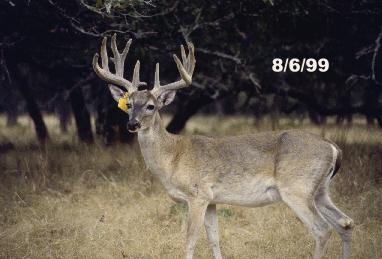
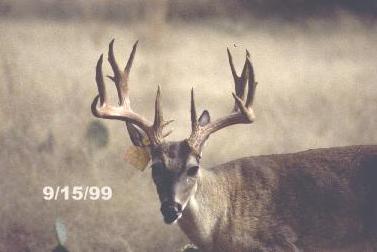
Antler Growth Increases with Age
Whitetail bucks drop or shed their antlers during the late winter and early spring. Fortunately, they grow them back annually. Antler growth in bucks generally increases annually as a buck ages, gets older. Substantial increases in antler size (and score) can be observed as a buck goes from 1 to 5 or 6 years of age.
White-tailed deer do not complete skeletal growth until about 3 years of age. During this time, bucks put a lot of the same materials that are used for the growth of antlers into long bones and other parts of their skeletal system. This one of the primary reasons that a buck’s antlers often make a noticeable jump from 3 to 4 years old — skeletal growth is complete and many of the antler growing supplies are now stored in those bigger bones.
Environmental Effects on Deer Antler Growth
The annual cycle of antler growth is amazing. I and hunters like myself enjoy watching particular bucks from year to year. Often times, antler configuration makes it possible to ID most bucks in subsequent years. A whitetail buck will typically show an increase in antler growth until at least age 6, possibly older. Most of the potential will be realized by 5 years of age.
Nutrition plays a role in a buck’s antler size. Bucks that have good, stable food sources provided by high quality habitat will produce better antlers than those of the same age that lack adequate nutrition. To take it further, precipitation plays a role in annual antler growth, especially as you go West in the whitetail’s range. High quality habitat can turn into mediocre habitat when it’s dry and protein-rich foods are not available.
I have an 8 point whitetail that has been coming in to my feeders for about 3 years. The buck is easily identified by a split right ear. This year he has not shed his antlers and about two weeks ago I noticed two additional points on his right antler, including a drop tine. I have never seen or heard of this happening. Can anyone enlighten me? I have pictures on file of him over the past two years if anyone is interested.
If a buck has 4 points one year will it have like 5 or 6 points the following year?
Alan, it depends on the age of the buck. A yearling buck (which is 1 1/2 years old and should not be confused with a fawn) with 4 points WILL probably be a 6, 7, or 8 point buck the next year (2 1/2). However, a buck with 4 points at age 3 1/2 or older likely has poor genes for antler growth and will likely NOT get any better.
How do you estimate the width of whitetail deer antlers by a picture?
Mark, the best way is to use the bucks’s ears as a guide. In Texas, 1.5 to 3.5 year old bucks, when their ears are in the alert position, have ear tip to ear tip spreads of about 13 inches. Mature bucks at 5.5 to 6.5 years old have tip to tip spreads of about 15 inches.
Since there are well over 30 subspecies of whitetail in North America, you will have to ask local hunters or taxidermist for good averages for your area. And keep in mind that tip to tip spread increases slowly with age.
I was told that a spike will always be a spike, that an 8 point will always be an 8 point, and so on and so on. Is this true, because I thought that the rack grew in relation to age and quality and quantity of food? Could you explain this to settle a small argument. Thanks.
John, it is very rare that a spike will stay a spike. Most end up being at least 8 point bucks down the road. The fact of the matter is that a yearling buck (1.5 years old) can be a 2 to 10 point deer. Most end up being 4 to 8 points. In general, as a buck ages it adds points, with most maxing out at 8. Young bucks that have a high number of points are more likely to have a higher number of points at maturity than a young buck that starts with a low number of points. This is the genetic component of antler growth.
Food quality and quantity, as you stated, can also play a role. A deer that has a poor diet, even if it has the genes to grow good antlers, will not progress “normally” and reach his full potential. So yes, bucks generally increase in points with age, but only up to a certain point.
Can a 10 point buck one year go down to an 8 point, or will he stay 10 or better?
In general, bucks tend to maintain or increase the number of points on their antlers each year. However, if bucks begin to suffer nutritionally, then their antlers can take a hit and decline. However, this is not permanent. If a buck’s level of nutrition increases in following years then antler growth will rebound. So yes, bucks can drop points and gain them back, but deer with good, constant nutrition usually don’t do this.
Thanks. The reason we were asking is because we got pics of an 8 point buck this year that looks exactly like last years 10 point. The next biggest buck last year was a small 6 that had a big body, and then a couple of 4 pointers, After reading the previous postings, I can see that those young bucks from last year could be 8s this year.
Your eight could’ve been last year’s ten. They do sometimes depreciate with old age.
AT WHAT POINT DURING ANTLER GROWTH IS IT POSSIBLE TO KNOW FOR SURE OR IS THERE A POINT AT WHEN A BUCK HAS ALL THE POINTS HE WILL GET FOR THE YEAR AND THEN JUST GROWS THE LENGTH AND FILLS OUT?
George, that’s a good question. On our ranch, we usually have a good idea of exactly what we’re looking at points-wise by early to mid-August (sometimes sooner, it all depends if the bucks have non-typical points). Every place could be different. Set out some trail cams and take pics starting early July. Compare the pics to what the deer look like during hunting season and you should be able to nail down the dates of when you could definitively tell.
Hi, I was wondering is it be possible for a 1 1/2 year old buck to be an eight pointer?
Kyle, the answer to your question is YES! The bucks with the best genetic potential will have 8 or more points as yearling (1 1/2 year old) bucks. Unfortunately, many of these deer get harvested before mature.
Kyle, if you have a 1.5 yr old eight, you’ve got a future great buck right there. If you guys are good at aging deer, that could be a heck of a buck at maturity…but like Buck Manager stated, not many of them make it that far. Someone shoots it sooner because their rack even before maturity will be impressive.
Two questions: I have a nice 10 point non-typical that is hanging out around my stand. The right antler is a little messed up, but the left is beautiful. If I pass on him this year, could he end up with a good typical rack next year? Also, I have a LARGE 6 pointer with a very big base around 3 inches. What are your ideas on taking this deer? Thanks.
Joe, there is a very good chance that the first buck you mentioned incurred some type of damage during antler growth. I would recommend shooting the 6 point buck. From what you said, my guess is that it is an older deer, or at least middle-aged. Either way, it should have more than 6 points. Shoot that deer!
I have a set of sheds from a whitetail deer. Nice 10 pount. Each tine has a long growth, then a knot that looks almost like a knuckle on a finger and then 1-2-3 inches of additional growth. This occurs on every tine on the rack. What would cause this?
Richard, the knots you are referring to are commonly called antler “acorns” by many deer hunters. These acorns are caused from an injury when the animal was in the velvet. The soft, thin tips of the antlers get bumped, causing a small crack or break. The blood flow is still good because the skin/velvet is not torn and antler growth continues. As a result, the bone/tissue is filled in and creates a bump in the antler, which somewhat resembles a knot or acorn.
I have several spikers on my property in the UP of Michigan. They look to be about 1.5 years old and their spikes are about 6″ to 8″ tall. Will they have a chance to grow more points as they mature?
Mary, spikes will continue to gain antler points as they age.
We have several young bucks with no brow tines. I have always heard that bucks with no brow tines started out as spikes. Is this true and should these bucks be taken out as culls?
Danny, if you are talking about 2 and 3 year old bucks then, yes, I would recommend that you harvest them. It would not be a bad idea to shoot any buck 2 1/2 years of age or older that is missing brow tines.
Can a young buck born in the Spring develop spikes or antlers with 4 or more points by the fall of the same year (six or seven months)?
Jay, the answer to your question is no. A buck fawn will not develop antlers the same year in which it was born. The fawn will produce two nubs on the top of its head where the antlers will be in the future, but these do not develop into hardened antler material. In fact, buck fawns, which are somewhere around 6 months old during hunting season, are commonly mistaken for does by hunters.
A buck begins growing its first set of antlers during the late Spring following the year it was born, when the buck is almost 1 year of age. They commonly develop two to eight points. A buck with it’s first set of antlers is called a yearling buck and is about 1 1/2 years old during hunting season.
I was curious if a 1.5 year old buck that is a 5 point, meaning 3 on one and 2 on the other, has potential to become a nice 8 or 10 point. Plus does it reflect anything on the potential growth if the young buck has no brow tines at this early stage of antler growth. Also, if a 3 year old is an eight what are the odds for him getting bigger and better. I guess I’m wanting to know if they are shooters or not right now. Thanks.
Dave, yes a yearling buck with 5 points will more than likely have at least 8 points, maybe even more. The majority of bucks will be at least 8 points by the time they are 2 to 3 years old, but the more points at buck has as a yearling (1.5 years old) the more potential it has down the road. Yearling antler quality is as good an indicator as we have for future antler potential. If a buck has only 8 points at 3 years old, the odds are that he will not gain points. A really good deer, antler-wise, should have 10 or more points at 3 years of age. What you shoot or don’t shoot depends on your management goals.
My Dad’s ranch in Texas has a lot of 4 and 6 point deer on it. How long will it be before the 6 points and the 4 point will become either 8 or 10 point deer? Also is there any thing we can do to promote antler growth? I have heard that feeding them with certain foods will accelerate antler growth. Thanks.
Troy, the majority of 4 and 6 point bucks should have 8 points the following year, assuming the bucks you are seeing now are 1 1/2 years old. No doubt about it, feeding feeds high in protein will help antler growth, just make sure you have a plan before throwing a bunch of feed/money at them. If the buck to doe ratio is not where it needs to be, most of the feed will go towards does and fawn production. And that is okay if that’s your plan.
Buck Manager, this year I decided to set out trail cameras so I could see the deer I have. I put them out the first of June but the pictures I have don’t show much antler growth and I know I got big bucks on the property. Are southern states like Tennessee behind others on deer antler growth or am I just not seeing my big bucks?
When they say deer can grow x amount per day, is that growth on each horn or overall? Also I live in the upper Midwest. When can I expect deer to be done growing here?
i would bet a dollar against a donut that he sustained an injury to that side of his body. the most common reason for deer develpoing additional points is in that instance. thier bodies push nutrients to the injured side to assist in the healing process and the antler from that side benefits. He probably wont have those additional points next year, so if he meets your personal management criteria, I would throw an arrow at him.
Is it possible for a 1 year old deer to have a beautiful 25 point rack or is this deer well over 1 year old?
Roger, anything is possible! But my guess is that the buck you are seeing is over one year old. Very few bucks ever have 25 antler points, so the deer you are seeing is very, very special.
I have pictures on new property of a fork, but his head structure, coloring, and body look to be that of a very old deer. Any insight on if this deer may be diseased? Possibly lack of nutrition for the poor antler growth? Maybe this deer is very old and therefore no longer can grow a full set of antlers?
Mat, the buck could have issues, but it sounds like you are right in your final assessment. I suspect the buck is very old and may be declining rapidly. Once a deer gets very old and their teeth very worn, it’s difficult for them to get adequate nutrition. Antler growth will be impact first.
I love looking for sheds, when is the best time to go out? My lover calls me a shed junkie. My garage is full of them.
Today while driving a school bus route I saw a buck going across a picked bean field less than 150 yards from the road with his full rack. He had a nice tall and long rack of 6-8 points. I’ve never seen a buck with a rack this late. Has anyone else seen this? I live in Iowa.
I have an 11 point who just walked past my window with both antlers intact. Last year he lost one antler at the end of January and kept the other one for another 6 weeks. He’s at least 8 years old and I’m not sure if this is unusual or not.
Great info! I came to your page because last night while taking out the garbage there was a nice sized 6 point buck in the street, with a much younger buck, just out for a stroll. This is in Berkeley California. We have a lot of deer roaming around pretty much all the time, but it’s rare to see such a nice buck. Because these are urban deer they let me get within about 10 feet, but none of the three of us felt like getting any closer than that. Thanks again for the information!
We have trail pics of several bucks. Most of them, which appear bigger massed, still have their velvet. One deer has already lost all of it’s velvet. They are all 8 points. Was he just ready to lose his velvet or would something cause him to lose it sooner than the others?
Laurel B, typically the older more mature bucks shed velvet first. The deer in question could be quite old and past his prime, maybe explaining the relatively thin antlers, or the buck could have had some type of illness that impacted hormones. Of course, it could just be the way it worked out. Somebody has to go first.
My friend shot a buck this season and it looks like it has 3 sets of antlers. I was wondering what would make the antlers grow like that. Is there anyway i can send a picture, to explain what I mean?
Why are some antlers white and some dark?
Jack Morgan, i a deer doesn’t lose its velvet it is either actually a doe that has grown antlers or, as in your case, an identifiable buck that hasn’t lost his velvet. I just saw a buck a week ago in full velvet the first week in December. We checked to see if it was actually a doe but it wasn’t, looked to be a buck that didn’t have any testicles. Probably have to shoot him to see. Not totally sure he will let you check if you don’t. LOL
Can a whitetail buck be a 10 point one year and an 8 point the next year? If he is old and on the decline?
I have a 5 1/2 year old buck that is a nine point. Do you think there is a possibility that he may become a 10 point or do you think he will stay a nine point. He has been a 9 point the last 3 years and I’ve been hoping for him to get that 10th point, and of course I love having him pass on his genes.
Nick, your deer will likely remain a 9 point buck. Addressed your question in much more detail here: antler growth and development in bucks.
I have what looks to be about a four to four n a half year old typical twelve as of three weeks ago. I’ve never taken a buck of this caliber and badly want to take him in October. If I were to hold out one more year, what can I expect as far as growth wise in inches? If I had to guess I would say he will be pushing the 160’s. Thank you.